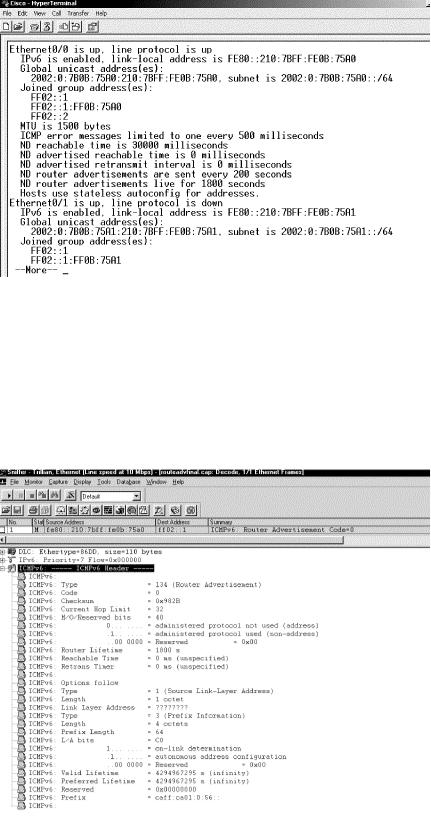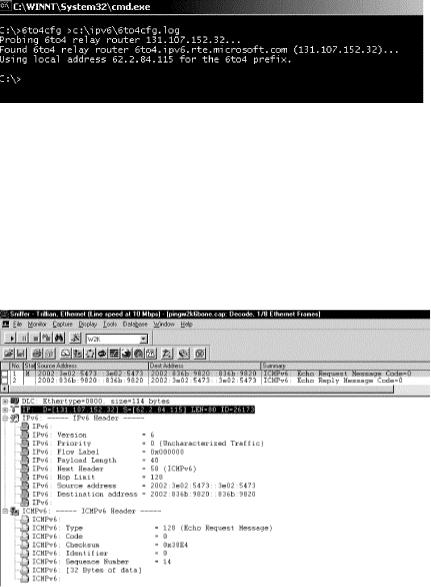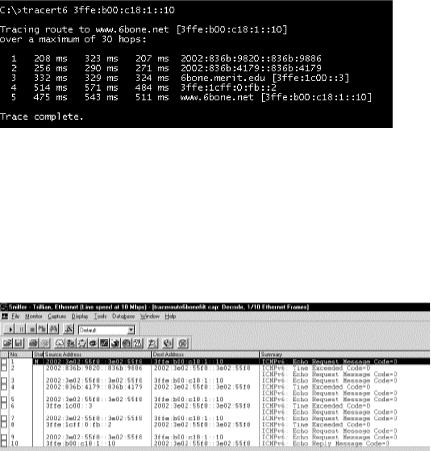
IPv6 Essentials
.pdf
Figure 11-4. Verifying the interface configuration
The output shows that I have a link-local address with the prefix FE80 and a global unicast address with the prefix 2002. The multicast group addresses joined are FF02::1 (all nodes), FF02::2 (all routers), and FF02::1:FF0B:75A0 (solicited-node multicast address). A list with all the configuration options follows, stating timers, intervals and address configuration options. Other tools that can be used on Cisco's current IOS are ping, traceroute, and a DNS client, all operational in IPv6.
Figure 11-5 shows the Router Advertisement in the trace file.
Figure 11-5. Router Advertisement in the trace file
The router sends the advertisement to the all-nodes multicast address ff02::1, so all nodes on the link receive it. Looking at this packet in the detail window, we can see how the router is configured. The hop limit is set to 32. DHCP (administered protocol) is not used for address information, but is used by the
201

hosts to get non-address-related information through DHCP. The lifetime is configured for 1,800 seconds. The Type field is set to 3 for prefix information. The prefix length is 64 bits and the lifetime is set to infinite. The prefix advertised in this case is caff:ca01:0:56::/64. This is what I had configured on the router prior to taking this trace file. All hosts that boot on this link send out a Router Solicitation message and receive this Router Advertisement. They learn all the parameters, including the prefix information from the router, and autoconfigure for an IPv6 address.
11.6 Description of the Tests
You will all go through these steps sooner or later, but I thought I'd share my first tries with you.
I started out with two hosts. One host is a Windows 2000 machine running the Microsoft Research stack. I called this host Marvin. The second host is a SuSE Linux host, also running an IPv6 stack. That host's name is Ford. Communication between the two hosts has not been an issue. In the absence of a router, they both autoconfigured for a link-local IPv6 address, using the 48-bit MAC identifier to build the address.
The Windows 2000 host Marvin has the following configuration:
MAC address |
00-02-B3-1E-83-29 |
IPv4 address |
62.2.84.115 (network range of our ISP, public IPv4 address) |
IPv6 address |
fe80::202:b3ff:fe1e:8329 |
The Linux host Ford has the following configuration:
MAC address |
00-A0-24-C5-32-56 |
IPv4 address |
192.168.0.99 (local network) |
IPv6 address |
fe80::2a0:24ff:fec5:3256 |
11.6.1 Pinging with IPv6
The first success was the verification of IPv6 communication by pinging each host as follows. Open a command window on Marvin and issue the following command:
ping6 fe80::2a0:24ff:fec5:3256
Do you want to know what a ping with IPv6 looks like? Have a look at Figure 11-6.
202

Figure 11-6. Trace file with an IPv6 ping
Frame 1 is the Echo Request from Ford; Frame 2 is the Echo Reply from Marvin. The screenshot shows the two MAC addresses configured for a link-local IPv6 address (prefix fe80). Between the third and fourth byte of the MAC address, fffe is inserted. The Payload Length field tells us the length of the data carried after the header. Remember from Chapter 2 that this field calculates the length in a different way than we are used to from IPv4. The length of the IPv6 header is not included in the calculation. The Next Header field is the same field as the Protocol Type field in IPv4. (The table with all the protocol numbers can be found in Chapter 2.) Protocol number 58 specifies ICMPv6. The ICMPv6 header shows what type of ICMP message this is. (A table listing all the ICMP message types can be found in Chapter 4.) Message type 128 is an Echo Request, and 129 is an Echo Reply. The identifier and sequence number are used to match requests and replies. All these fields are important when you need to troubleshoot.
To understand ICMPv6 and become familiar with the whole range of functionality, refer to Chapter 4.
11.6.2 Pinging the 6Bone over the IPv4 Infrastructure
Pinging with IPv6 is cool, but the local ping quickly got boring. So I decided that I wanted to ping some hosts on the 6Bone and, even more exciting, visit some IPv6 web sites. Good thought, but how do I get out there? After all, my ISP still has an IPv4-only infrastructure.
The Microsoft documentation helped me a step further with the description of how to use 6to4cfg.exe (replaced by netsh on Windows XP), a tool that is used to configure tunnels for IPv6 to be carried over an existing IPv4 infrastructure. The requirement for this host is to have a public IPv4 address. The 6to4.exe tool autoconfigured a public IPv6 address for my host by using the public IPv4 address and turning it into a public IPv6 address.
Figure 11-7 shows the output of the 6to4cfg.exe command when autoconfiguring.
203

Figure 11-7. Using 6to4cfg.exe on a Windows 2000 host
The screenshot shows a relay router name of 6to4.ipv6.rte.microsoft.com with an IPv4 address of 131.107.152.32. This is a router that can be used by anyone wishing to establish tunneled IPv6 communication to the 6Bone. It can be found in the Microsoft documentation about the IPv6 research stack. This host has an IPv6 address of 2002:836b:9820::836b:9820. 6to4cfg.exe uses our local IPv4 address as prefix for 6to4 configuration.
Sometimes things work as expected, so I was able to capture the trace file in Figure 11-8. It shows how the IPv6 ICMP message is encapsulated into an IPv4 packet.
Figure 11-8. Pinging the 6bone through an IPv4 infrastructure
The summary line shows the Echo Request and the Echo Reply and the two beautiful IPv6 addresses. The IPv4 layer (highlighted in the detail window) shows a source address of 62.2.84.115, which is my local host's public IPv4 address used to access the Internet. The destination address of 131.107.152.32 is the IPv4 address of Microsoft's relay router (refer back to Figure Figure 11-7). This router will know how to treat the ICMPv6 packet. The Protocol field in the IPv4 header, which cannot be seen in this screenshot, has the value 41 for IPv6.
11.6.3 Traceroute with IPv6
Skeptical as I am, I decided to check on traceroute next. Remember, traceroute uses Echo Request and Reply messages. By raising the hop limit by one for every packet, traceroute forces all routers on the path to a given destination to send back an ICMP Time Exceeded message. This way, the source host gets a list of all routers along the path. And it worked!
Note that traceroute on a Microsoft machine with the current IPv6 research stack is done by issuing tracert6.exe, as can be seen in Figure 11-9.
204

Figure 11-9. tracert6 to www.6bone.net
I issued tracert6.exe for 3ffe:b00:c18:1::10, which is the IPv6 address of www.6bone.net. The first hop 2002:836b:9820::836b:9886 is the endpoint of the tunnel. To get there, any number of hops is possible. tracert6 cannot provide any information about the tunnel. Only the hops from the end point of the tunnel to the final destination are displayed.
Figure 11-10 shows how this same command looked when tracing it with Sniffer.
Figure 11-10. tracert6 to the 6Bone in the trace file
The first frame shows the first Echo Request sent to the final destination. This packet has a hop limit of 1. The first router in the path, 2002:836b:9820::836b:9886, replies with a Time Exceeded message. Frames 2, 4, 6, 8, and 10 are the replies from the routers along the path to the destination. Compare the source address of these replies with the tracert6 output in Figure 11-9, and hey, do they match?
11.6.4 Browsing with IPv6
After mastering ping6 and tracert6, I wanted more. How about browsing web sites? I looked for web sites that are accessible over IPv6-only and tried to get there.
On the Microsoft platform, the new Internet extensions dynamic link library, wininet.dll, allows web browsers to access IPv6-enabled web servers. For example, wininet.dll is used by Microsoft Internet Explorer to make connections with web servers and view web pages. Internet Explorer uses IPv6 to download web pages in the following circumstances:
•The DNS query for the name of the web server in the URL returns an IPv6 address.
•On Windows NT and Windows 2000 with the IPv6 Technology Preview Stack, you can also use an URL in the format for literal IPv6 addresses, as described in RFC 2732. A literal IPv6 address in a URL is the address enclosed in square brackets. For example, to reach the web server at the IPv6 address 2010:836B:4179::836B:4179, the URL is http://[2010:836B:4179::836B:4179].
For a list of IPv6-accessible web sites, see http://www.ipv6.org/v6-www.html. Accessing IPv6-only web sites assumes that you have connectivity to the 6Bone.
205

Your browser cannot browse IPv6 web sites if it is configured to use a proxy server. When the browser is configured to use a proxy server, all name-resolution requests for web sites are forwarded to the proxy server. Unless the proxy server is IPv6-enabled, proxy-based requests for local or remote IPv6 web pages will not work.
From the list of IPv6-accessible web sites, we chose http://ipv6.research.microsoft.com. Figure 11-11 shows the welcome screen at this site.
Figure 11-11. Welcome to the future
Let's hope that the future is a little more colorful than this welcome site. But our IPv6 stack is obviously ready to surf the web over IPv6.
I have done many more experiments in my lab, including FTP and Telnet. To see some of those trace files, refer to Chapter 9. But most importantly, play for yourself and make your own trace files. That's much more fun.
11.7 Vendor Support
A great number of vendors already support IPv6 and the list grows daily. I had to make a choice for my test network. There are many other vendors and operating systems that you can use to play with. The IPv6 Forum has a list of members with links to the vendor sites. They all have IPv6 position papers published. To get updated information, visit your vendor's IPv6 site. Here is a list of position papers, dated October 2001.
Vendor |
Web site |
Microsoft |
http://www.microsoft.com/ipv6/ |
IBM |
http://www.ibm.com/software/ipv6/ |
Cisco |
http://www.cisco.com/ipv6/ |
Nokia |
http://www.nokia.com/ipv6/ |
Alcatel |
http://www.cid.alcatel.com/ipv6/index.html |
SUN |
http://www.sun.com/solaris/ipv6/ |
Trumpet |
http://www.trumpet.com.au/ipv6/ |
BITS Pilani |
http://ipv6.bits-pilani.ac.in/case-for-v6/ |
6WIND |
http://www.6wind.com/ipv6.html |
Compaq |
http://www.compaq.com/ipv6/ |
Consulintel |
http://www.consulintel.es/html/ipv6/ipv6.htm |
Nortel Networks |
http://www.nortelnetworks.com/ipv6/ |
Hewlett Packard |
http://www.hp.com/products1/unixserverconnectivity/software/ipv.html |
206

Mentat Inc. |
http://www.mentat.com/tcp/tcp.html |
Ericsson |
http://www.ipv6forum.com/navbar/position/Ericsson-IPv6-statement.pdf |
Hitachi |
http://www.v6.hitachi.co.jp |
RIPE/NCC |
http://www.ripe.net/annual-report/ |
NTT |
http://www.v6.ntt.net/globe/index-e.html |
ETRI Korea |
http://www.krv6.net |
Ipinfusion |
http://www.ipinfusion.com/ipv6_network-processing_white_paper0727.pdf |
For a current list of available implementations, refer to http://playground.sun.com/pub/ipng/html/ipngimplementations.html (sorted by vendor) and http://www.ipv6.org/v6-apps.html (sorted by application).
207

Appendix A. RFCs
If you want to learn more about IPv6, you need to read RFCs. This appendix provides an overview of the standards and the RFC process.
A.1 Standards
This part of the appendix provides an overview of the important things to know about RFCs and the RFC process. It also includes a list of IPv6-relevant RFCs.
A.1.1 General RFC Information
If you want to understand the role of the IETF and the standardization process, if you need a list of all the organizations involved in the process and a description of what they do, or if you wish to attend an IETF meeting, there is an interesting and humorous RFC that describes the background, processes, and rules: RFC 3160, titled "The Tao of IETF—A Novice's Guide to the Internet Engineering Task Force."
Requests for Comments (RFCs) are written reports describing most of the information regarding TCP/IP and the architecture, protocols, and history of the Internet. There are many sites on the Internet where RFCs are electronically accessible. The sites are very different, but most of them support some form of search mechanism. Find the site that best suits your preferences.
A good starting point is http://www.rfc-editor.org. There is a tribute to Jon Postel, father of the Internet, who died in October, 1998. He was the RFC editor. Besides this information, there is also an overview of the RFC series and process.
On the search and retrieve page of this site, there are many ways to access the wealth of information. RFCs can be viewed by number or in an index, they can be in forward or reverse chronological order, and they can be searched by author, title, number, or keyword. Of course, there is also a link to alternative RFC repositories.
RFC 2555 is an interesting overview of 30 years of RFC history and a good description of the contribution of Jon Postel's services to the Internet community. There is even more information about Jon Postel at http://www.postel.org/remembrances/.
The first RFC, RFC 0001, was published by Steve Crocker on April 7, 1969. Today the number of RFCs continues to rise quickly and has exceeded 3000. RFCs can have different statuses, such as standard, informational, experimental, and historic. A good overview of the different statuses and current level of standardization can be found at http://www.rfc-editor.org. Here's a short list of some important basic RFCs that you should be aware of:
RFC 3000, "Official Protocol Standard"
Known as the Internet Official Protocol Standard, this RFC lists only official RFC protocol standards and is therefore not a complete index. It contains the state of standardization as of October, 2001.
RFC 1700, "Assigned Numbers Document"
This RFC is now outdated. For many years, it has been a reference point, containing a summary of the assignment of protocol parameters for the Internet Protocol Suite. IANA is the central
208
coordinator for the assignment of these parameters. RFC 1700 has been replaced by an updated list at http://www.iana.org/numbers.html.
RFCs 1122 and 1123, Host Requirements Documents
These two RFCs are known as Host Requirements Documents and cover the requirements for Internet host software. RFC 1122 covers the communications protocol layers such as link layer, IP layer, and transport layer. RFC 1123 covers the application and support protocols. Many terms widely used throughout all RFCs are defined in these two documents.
RFC 1812, "Requirements for IPv4 Routers"
This RFC is self-explanatory. At the time of this writing, I have not yet found an RFC including requirements for IPv6 routers.
The RFCs ending on xx99 are usually a summary of a range of previous RFCs and their status. For instance, if you need a summary for the RFCs from 3000 to 3099, refer to RFC 3099.
A.1.2 RFC Index for IPv6
This is a list of all relevant IPv6 RFCs and RFCs regarding related technologies. It is sorted by RFC number.
A.1.2.1 General IPv6 RFCs
•RFC 1981, "Path MTU Discovery for IP version 6" (August, 1996)
•RFC 2003, "IP Encapsulation within IP" (October, 1996)
•RFC 2080, "RIPng for IPv6" (January, 1997)
•RFC 2185, "Routing Aspects of IPv6 Transition" (September, 1997)
•RFC 2205, "Resource ReSerVation Protocol (RSVP) Version 1 Functional Specification" (September, 1997)
•RFC 2207, "RSVP Extensions for IPSEC Data Flows" (September, 1997)
•RFC 2210, "The Use of RSVP with IETF Integrated Services" (September, 1997)
•RFC 2292, "Advanced Sockets API for IPv6" (February, 1998)
•RFC 2324, "Hyper Text Coffee Pot Control Protocol (HTCPCP/1.0)" (April, 1998) One of my favorites.
•RFC 2373, "IP Version 6 Addressing Architecture" (July, 1998)
•RFC 2374, "An IPv6 Aggregatable Global Unicast Address Format" (July, 1998)
•RFC 2375, "IPv6 Multicast Address Assignments" (July, 1998)
•RFC 2401, "Security Architecture for the Internet Protocol" (November, 1998)
•RFC 2402, "IP Authentication Header" (November, 1998)
•RFC 2406, "IP Encapsulating Security Payload (ESP)" (November, 1998)
•RFC 2407, "The Internet IP Security Domain of Interpretation (DOI) for ISAKMP" (November, 1998)
•RFC 2408, "Internet Security and Key Management Protocol (ISAKMP)" (November, 1998)
•RFC 2409, "The Internet Key Exchange (IKE)" (November, 1998)
•RFC 2411, "IP Security Document Roadmap" (November, 1998)
•RFC 2412, "The OAKLEY Key Determination Protocol" (November, 1998)
•RFC 2428, "FTP Extensions for IPv6 and NATs" (September, 1998)
•RFC 2450, "Proposed TLA and NLA Assignment Rules" (December, 1998)
•RFC 2452, "IP Version 6 Management Information Base for the Transmission Control Protocol"
•RFC 2454, "IP Version 6 Management Information Base for the User Datagram Protocol" (December, 1998)
•RFC 2460, "Internet Protocol, Version 6 (IPv6) Specification" (December, 1998) Obsoletes RFC 1883.
209
•RFC 2461, "Neighbor Discovery for IP Version 6 (IPv6)" (December, 1998) Obsoletes RFC 1970.
•RFC 2462, "IPv6 Stateless Address Autoconfiguration" (December, 1998)
•RFC 2463, "Internet Control Message Protocol (ICMPv6) for the Internet Protocol Version 6 (IPv6) Specification" (December, 1998)
•RFC 2465, "Management Information Base for IP Version 6: Textual Conventions and General Group" (December, 1998)
•RFC 2466, "Management Information Base for IP Version 6: ICMPv6 Group" (December, 1998)
•RFC 2471, "IPv6 Testing Address Allocation" (December, 1998)
•RFC 2473, "Generic Packet Tunneling in IPv6 Specification" (December, 1998)
•RFC 2474, "Definition of the Differentiated Services Field (DS Field) in the IPv4 and IPv6 Headers" (December, 1998)
•RFC 2475, "An Architecture for Differentiated Services" (December, 1998)
•RFC 2507, "IP Header Compression" (February, 1999)
•RFC 2526, "Reserved IPv6 Subnet Anycast Addresses" (March, 1999)
•RFC 2529, "Transmission of IPv6 over IPv4 Domains without Explicit Tunnels" (March, 1999)
•RFC 2545, "Use of BGP-4 Multiprotocol Extensions for IPv6 Inter-Domain Routing" (March, 1999)
•RFC 2553, "Basic Socket Interface Extensions for IPv6" (March, 1999)
•RFC 2675, "IPv6 Jumbograms" (August, 1999)
•RFC 2710, "Multicast Listener Discovery (MLD) for IPv6" (October, 1999)
•RFC 2711, "IPv6 Router Alert Option" (October, 1999)
•RFC 2732, "Format for Literal IPv6 Addresses in URLs" (December, 1999)
•RFC 2740, "OSPF for IPv6" (December, 1999)
•RFC 2765, "Stateless IP/ICMP Translation Algorithm (SIIT)" (February, 2000)
•RFC 2766, "Network Address Translation-Protocol Translation (NAT-PT)" (February, 2000)
•RFC 2772, "6Bone Backbone Routing Guidelines" (February, 2000)
•RFC 2874, "DNS Extensions to Support IPv6 Address Aggregation and Renumbering" (July, 2000)
•RFC 2893, "Transition Mechanisms for IPv6 Hosts and Routers" (August, 2000) Obsoletes RFC 1933.
•RFC 2894, "Router Renumbering for IPv6" (August, 2000)
•RFC 2921, "6BONE pTLA and pNLA Formats (pTLA)" (September, 2000)
•RFC 2925, "Definitions of Managed Objects for Remote Ping, Traceroute, and Lookup Operations" (September, 2000)
•RFC 2928, "Initial IPv6 Sub-TLA ID Assignments" (September, 2000)
•RFC 3019, "IP Version 6 Management Information Base for The Multicast Listener Discovery Protocol" (January, 2001)
•RFC 3041, "Privacy Extensions for Stateless Address Autoconfiguration in IPv6" (January, 2001)
•RFC 3053, "IPv6 Tunnel Broker" (January, 2001)
•RFC 3056, "Connection of IPv6 Domains via IPv4 Clouds" (February, 2001)
•RFC 3068, "An Anycast Prefix for 6to4 Relay Routers" (June, 2001)
•RFC 3111, "Service Location Protocol Modifications for IPv6" (May, 2001)
•RFC 3122, "Extensions to IPv6 Neighbor Discovery for Inverse Discovery Specification" (June, 2001)
•RFC 3142, "An IPv6-to-IPv4 Transport Relay Translator" (June, 2001)
•RFC 3162, "RADIUS and IPv6" (August, 2001)
•RFC 3177, "IAB/IESG Recommendations on IPv6 Address" (September, 2001)
•RFC 3178, "IPv6 Multihoming Support at Site Exit Routers" (October, 2001)
•RFC 3175, "Aggregation of RSVP for IPv4 and IPv6 Reservations" (September, 2001)
•RFC 3209, "RSVP-TE: Extensions to RSVP for LSP Tunnels" (December, 2001)
•RFC 3226, "DNSSEC and IPv6 A6 aware server/resolver message size requirements" (December, 2001)
210
